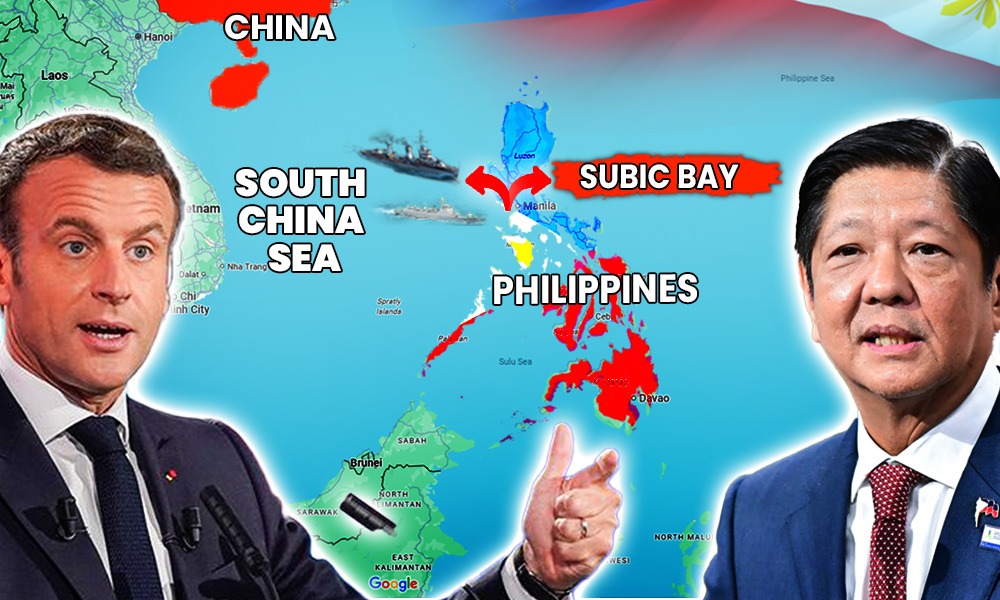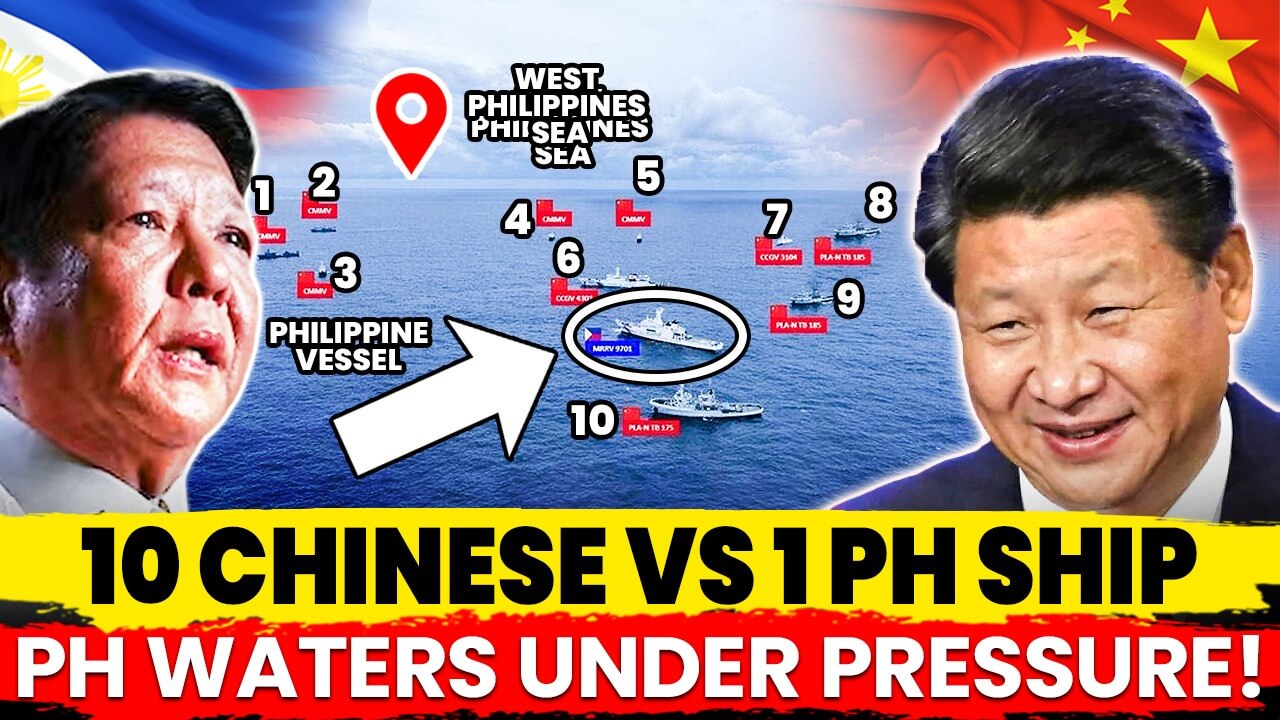Breaking Headlines: “Subic Bay gets elite recognition from France, the ONLY port in Asia-Pacific to earn such praise!” While the world’s attention is focused on regional power struggles, France’s powerful Clemenceau 25 carrier strike group just delivered a strategic message loud and clear: Subic Bay isn’t just back, it’s indispensable. This wasn’t a casual compliment. It was a direct, military-grade endorsement of the Philippines as a critical defense ally in the Indo-Pacific.
Subic Bay wasn’t chosen for beauty or trade volume, it was chosen for what truly matters in modern naval strategy: deep-water access, swift entry, operational flexibility, and proximity to the most volatile flashpoints in the region, the South China Sea and Taiwan Strait. According to Rear Admiral Jacques Mallard, “Subic offers unmatched logistics and access. It’s a strategic gem.” Think about that. Not Singapore. Not Japan. Not Darwin. Just Subic.
But this goes way deeper. France is currently executing its Indo-Pacific strategy, one focused on freedom of navigation, regional cooperation, and counterbalancing Chinese expansion. So when the French Navy docks in Subic and calls it the best, it’s not just admiration, it’s a diplomatic alignment. It’s France saying: “We trust the Philippines. We want you in this game.” That’s a loud message to allies, and a louder one to rivals.
Subic Bay is already responding. The Philippines has begun expanding its naval footprint there, with U.S. rotational troops increasing under EDCA, Japan and Australia preparing for joint exercises, and private operators upgrading infrastructure for military and trade use. Defense Secretary Gilbert Teodoro recently said, “Subic will be our crown jewel for security and cooperation.” This isn’t just talk, it’s in motion.
With this momentum, Subic is becoming a hub for not only defense, but economic resilience. Its location makes it ideal for strategic logistics and disaster response, which means more foreign interest, more infrastructure funding, and more geopolitical weight for the Philippines. We’re not just reacting anymore, we’re shaping the regional balance.
This moment matters. As China builds artificial islands and tensions rise over Taiwan, Subic Bay is quietly turning into the most valuable real estate in Southeast Asia. France has noticed. Other allies are following. And for every Filipino, this isn’t just about military alliances — it’s about national pride, security, and the future. When history books talk about the new Indo-Pacific order, don’t be surprised if Subic Bay is on the front page.
The WHY Behind France’s Praise: Subic Bay Through the Eyes of the French Navy
So why did the French Navy, out of all the ports in the Indo-Pacific, choose Subic Bay as the standout? To understand this, we need to zoom in on Mission CLEMENCEAU 25, France’s high-stakes military deployment to the Indo-Pacific. This wasn’t just a naval cruise. This was about projecting power, asserting freedom of navigation, upholding international law, and showing France means business in the Indo-Pacific. At the center of this mission? The nuclear-powered aircraft carrier Charles de Gaulle, the pride of the French Navy, supported by destroyers, supply ships, and a full strike group. When that kind of firepower docks at your port and praises it, you pay attention.
Rear Admiral Jacques Mallard, commander of the French carrier strike group, didn’t mince words: “Subic Bay is an ideal location to support our carrier group. The environment is favorable, the infrastructure is here, and the industrial landscape is efficient.” This wasn’t a political courtesy. It was a tactical evaluation and Subic passed with flying colors.
Let’s talk specifics. Subic Bay’s natural depth reaches up to 13.7 meters, deep enough to host massive naval vessels, including aircraft carriers and submarines. It has no navigational chokepoints, making entry and exit swift, a priceless advantage during crises. Add to that the pre-existing U.S.-built infrastructure, from fuel depots to drydocks, and you’ve got a military-grade port ready to support the world’s most advanced naval platforms.
And that’s exactly what France experienced. The Charles de Gaulle, with its nuclear core and over 30 aircraft aboard, needs serious logistics. And Subic delivered. From resupply to shore coordination, the visit showed that the Philippines isn’t just a stopover, it’s a strategic enabler.
By choosing Subic Bay, France wasn’t just giving a compliment, it was making a statement. A European nuclear power placed its most advanced warship and combat group in the care of the Philippines and left impressed. That’s trust. That’s capability. And that’s exactly why Subic Bay is back in the global defense spotlight.
From U.S. Naval Fortress to Economic Powerhouse: Subic Bay’s Bold Transformation
Before France saluted it, and before modern warships called it “ideal,” Subic Bay was already a legend. This story goes back centuries, starting as a Spanish naval arsenal in the late 1800s, then becoming one of the most powerful American military bases in the world. By the Cold War era, Subic wasn’t just a port, it was the largest U.S. Navy installation in Asia, playing a massive role in both the Korean War and the Vietnam War as a logistics, repair, and combat staging hub.
Thousands of U.S. sailors, nuclear submarines, aircraft carriers, and warplanes called Subic home. It was a mini America in the Philippines, until 1992, when history took a turn. The eruption of Mount Pinatubo, coupled with the Philippine Senate’s decision not to renew the U.S. bases agreement, led to a dramatic U.S. withdrawal. In many places, that would’ve been the end, a ghost town left behind.
But not in Subic.
What happened next is nothing short of heroic. With no national funding, no military, and no clear future, over 8,000 volunteers, mostly ordinary citizens, stood guard over the entire base. Leading them? Then-Olongapo Mayor Richard Gordon. He and his people protected every facility, from power plants to barracks, from looters and decay. And they didn’t stop there, they transformed it. What was once a war hub became the Subic Bay Freeport Zone, a bold experiment in local-driven, volunteer-powered economic revival. “We showed the world what Filipinos can do when we take charge of our destiny,” Gordon once said and he meant it.
160 Miles from Taiwan, The United States is Building a Base in the Philippines to Deter China
Fast forward to today, and Subic is a commercial and military hybrid zone. It hosted major global shipyards, including the once-massive Hanjin Heavy Industries, which sadly collapsed in 2019 but showed the port’s industrial potential. Subic also has a Master Ship Repair Agreement (MSRA) with the U.S. Navy, allowing American warships to undergo major repairs and maintenance locally, a rare and valuable arrangement. The port continues to handle container traffic, logistics operations, and foreign naval visits, including from the U.S., Japan, South Korea, and now, France.
Of course, Subic hasn’t had a perfect journey. The loss of Hanjin was a blow, and competition from larger commercial ports like Manila and Batangas has challenged its economic momentum. But make no mistake, Subic Bay is resurging, especially now that its strategic military value is being rediscovered by global powers.
From colonial port to Cold War fortress, from volcanic shutdown to volunteer-driven resurrection, Subic Bay is proof that history doesn’t just repeat, sometimes, it evolves.
Subic Bay: The Indo-Pacific’s New Strategic Star
Subic Bay isn’t just a port, it’s a geopolitical chess piece in a high-stakes maritime game. Located on the west coast of Luzon, Subic opens directly into the South China Sea, placing it within immediate range of key flashpoints like the Spratly Islands, Scarborough Shoal, and the Taiwan Strait. Its deep, naturally sheltered harbor (up to 13.7 meters) is rare in Southeast Asia and makes it ideal for housing everything from submarines to nuclear-powered aircraft carriers. That’s why France’s recent praise isn’t just symbolic, it’s strategic calculus.
For the Philippines, this recognition perfectly aligns with its evolving security strategy. In the face of growing Chinese assertiveness in the West Philippine Sea, Manila has been strengthening ties with democratic partners and France is stepping up. Beyond this naval visit, France and the Philippines have been discussing joint patrols, ramping up maritime defense cooperation, and even exploring military hardware sales, including naval helicopters and radar systems. The praise for Subic Bay sends a clear message: the Philippines is no longer just a regional player, it’s becoming a key operational ally.
Zoom out, and you’ll see an even bigger picture forming. France’s presence in the Indo-Pacific is part of a broader European pivot to the region. The UK’s HMS Queen Elizabeth carrier strike group visited in 2021. Germany deployed the frigate Bayern through disputed waters in 2022. These aren’t random tours, they’re calculated moves by European democracies to support freedom of navigation and push back against coercive maritime behavior. And for these far-reaching naval forces, Subic Bay is emerging as a crucial logistical lifeline. France’s interest in the port isn’t just about one visit, it’s about building a trustworthy base of operations in one of the world’s most contested maritime zones.
In short, Subic Bay’s revival isn’t just about Philippine pride, it’s about global strategy. As the Indo-Pacific becomes the center of 21st-century geopolitics, Subic is being reactivated not just as a port, but as a platform for regional security, diplomacy, and deterrence. And the world is docking here, one navy at a time.
Trump Sparks Global Trade War with Sweeping Tariffs on Canada, China, and Mexico
Looking Ahead: Subic Bay’s Strategic Comeback Is Just Beginning
France’s glowing praise of Subic Bay wasn’t just polite diplomacy, it was a calculated recognition of the port’s military logistics excellence, its deep-water advantages, and its irreplaceable location on the front lines of Indo-Pacific security. From its origins as a Spanish naval arsenal, to its decades as America’s most vital Asian base, to its modern rebirth as a strategic freeport, Subic’s journey tells a story of resilience, reinvention, and rising relevance.
Now, with the French Navy’s endorsement, Subic Bay is more than history, it’s a future-forward hub. Experts say this kind of international trust could unlock increased defense investments, more joint military exercises, and even permanent logistical agreements with allies. Already, analysts project a significant uptick in port modernization funding, foreign ship visits, and defense infrastructure upgrades within the next 3–5 years, all centered on Subic’s growing role as the Philippines’ maritime anchor in the West Philippine Sea.
And this is where the real message comes in: The Philippines is no longer a passive observer in regional security, it’s a strategic player with global trust. Subic Bay proves that we’re not just in the game, we’re hosting it. This is more than a proud moment. It’s a signal that Filipino ports, Filipino leadership, and Filipino geography matter deeply in the world’s most contested waters.
As global powers sail into the Indo-Pacific, they’re looking to the Philippines and Subic Bay, for stability, strength, and partnership. Let’s make sure we’re ready. Let’s own this moment. Because the spotlight is on us, and it’s only getting brighter.



